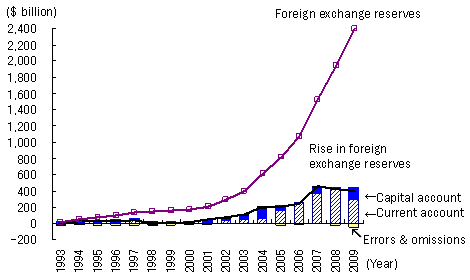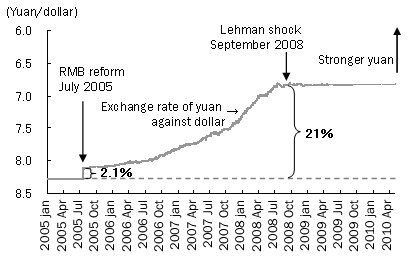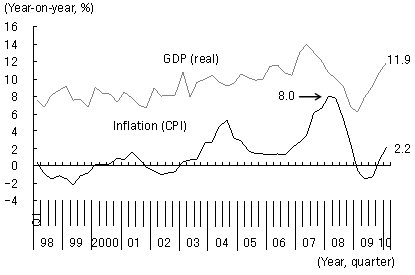* This article was first published on May 19, 2010 in Japanese. In line with the author's prediction, the yuan resumed its revaluation against the dollar on June 21, following an announcement by the central bank on June 19.
The yuan appreciated moderately against the dollar following China's move to a managed floating rate system in July 2005, but returned to the dollar peg system in July 2008 as part of the response to the global financial crisis. However, to keep the exchange rate of the yuan below the equilibrium rate, the central bank needs to intervene heavily in the foreign exchange market, and the accompanying expansion of liquidity has increased inflationary pressure and driven up real estate prices. Meanwhile, the United States is pressing China to revalue the yuan, criticizing China for manipulating it to give its companies an unfair advantage in global markets. Given these pressures, it seems inevitable that China will resume its revaluation of the yuan, and the time for that now appears to be approaching.
Twin surpluses create mounting pressure to revalue the yuan
As symbolized by an increasing balance of payments surplus and an accompanying surge in foreign currency reserves in recent years, the yuan has been under upward pressure ( figure 1 ). Although the Chinese authorities were initially reluctant to revalue their currency, given concerns about negative developments associated with a stronger yuan, such as an export slowdown, a deterioration in employment conditions, and deflationary pressure, they finally revalued the currency 2.1% and announced that they would "reform the renminbi (RMB) exchange rate regime" (the RMB reform) on July 21, 2005, breaking away from the dollar peg system they had hitherto adopted in response to growing pressure from the markets and foreign governments.
Figure1 : Rise in China's balance of payments surplus and foreign exchange reserve

(Note) Rise in foreign exchange reserves = current account balance + capital account balance + errors & omissions
(Source) State Administration of Foreign Exchange, http://www.safe.gov.cn/
With respect to the foreign exchange system adopted in July 2005, Professor Yu Yongding, then a member of the Monetary Policy Committee of the People's Bank of China, explains that it was the BBC system, which appears in textbooks of international finance, or a managed floating rate system based on band (currency band), basket (currency basket), and crawling (a procedure in which an exchange rate is allowed to edge up or down steadily) ("The Historic Decision to Reform the Yuan Exchange Rate Regime," Jinrong Shibao, July 23, 2005). The daily currency band was initially set at +/-0.3% around the daily fixing rate (middle rate) announced by the central bank, but was later expanded to +/-0.5%. With respect to the currency basket, although the weights of constituent currencies were not disclosed, it is likely that the dollar still accounted for the majority of the weight, judging by the degree of synchronization between the yuan and major currencies. The speed of crawling was decided by the government based on economic conditions. As just described, any rise in the exchange rate of the yuan against the dollar was controlled through market intervention by the central bank, with more emphasis on "management" than on "floating."
Although the rise in the yuan against the dollar initially remained at around 1% per annum, the authorities began accelerating the pace of revaluation since 2007 as part of its response to inflation ( figure 2 ). For three years from July 2005 when the RMB reform began, the yuan rose 21% against the dollar. However, as the global financial crisis that emerged from the United States became more acute, China returned to the de facto dollar peg system in July 2008, and since then the dollar-yuan exchange rate has remained stable in an extremely narrow range.
Figure2 : Changes in the Exchange Rate of the Yuan against the Dollar

(Source) State Administration of Foreign Exchange
Recently, however, inflationary pressure has been increasing in step with the economic recovery ( figure 3 ). In addition, with real estate prices also surging, the Chinese economy has been taking on the features of a bubble. Foreign exchange intervention to sell yuan and buy dollars to hold down any rise in the yuan exchange rate has also been helping to overheat the economy through the expansion of liquidity. It is expected that in the near future the authorities will be forced to revalue the yuan once again, together with an interest rate hike, to maintain stable growth.
Figure3 : Changes in GDP Growth and Inflation

(Source) State Administration of Foreign Exchange
Reemerging friction over the yuan between the United States and China
A revaluation of the yuan is necessary not only to cool down economic overheating but also to curb trade friction with the United States.
Once China moved to the managed floating rate system from the de facto dollar peg in July 2005, friction over the yuan between the United States and China eased. However, it reemerged following the inauguration of the Obama administration and the severe financial crisis in the United States. The renewed tensions began with the following statement on January 22, 2009 by Timothy Geithner, the former governor of the Federal Reserve Bank of New York who was appointed the Treasury Secretary by President Obama, in his written reply to a question of the Senate Finance Committee that was to approve the appointment: "President Obama believes that China is manipulating its currency. President Obama has pledged as President to use aggressively all the diplomatic avenues open to him to seek change in China's currency practices." Chinese Premier Wen Jiabao countered his argument, saying that "the suggestion that China manipulates the yuan is completely baseless."
Although the relationshFip between the two countries subsequently remained calm thanks to the visit to China by President Obama in November 2009, among other events, the friction resumed in 2010 with the meeting between President Obama and the 14th Dalai Lama and the U.S. shipment of arms to Taiwan. Criticism of China's currency practices mounted once again in the U.S. Congress.
However, efforts are clearly being made to heal the relationship between the United States and China. First, visits by high-level officials have picked up, with Treasury Secretary Geithner visiting China on April 8 and Hu Jintao, China's President, visiting Washington to attend the Nuclear Security Summit on April 12 and 13. In addition, the Treasury Department announced on April 3 that it would postpone the publication of the Annual Report to Congress on International Economic and Exchange Rate Policies, which was due to be published on April 15. If China had been identified as a country that manipulated its currency in the Report, a game of tit for tat between the two countries would have been unavoidable. This disastrous outcome was averted at least temporarily by the postponed publication of the Report.
RMB reform not for the sake of the United States but for the sake of China itself
In return, the United States expects China to resume a revaluation of the yuan soon. As important international meetings such as the U.S.-China Strategic and Economic Dialogue in late May and the G20 Summit on June 26 and 27 lie ahead, it is expected that China will take specific steps with an eye on these meetings.
In fact, at a press conference after the closing of the National People's Congress held in March 2010, Premier Wen Jiabao showed his willingness to work on reforms, saying that "we will continue to reform the RMB exchange rate regime and keep the RMB exchange rate basically stable at an appropriate and balanced level," while emphasizing that "we are opposed to the practice of mutual finger-pointing between countries, or even taking strong measures to force another country to appreciate its currency, because such practice is not in the interests of the reform of the RMB exchange rate regime."
In any near-term action regarding the yuan rate, China is unlikely to agree to U.S. demands for a significant revaluation, in order to avoid being seen to succumb to foreign pressure. Instead, China is expected to revalue the yuan only slightly (2.1% last time) and once again adopt the BBC system it introduced last time. To show "progress" in reforms, it is also expected that China will conduct some fine-tuning, such as expanding the currency band further from the current +/-0.5% around the daily fixing rate. However, an expansion of the currency band does not necessarily mean the acceleration of the revaluation of the yuan, as long as the central bank continues to announce the middle rate on a daily basis and tries to maintain it through market intervention. When considering the effect associated with the change in foreign exchange policy, attention should rather be paid to how fast the middle rate rises going forward (which corresponds to the crawling portion in the BBC system). It looks likely that the Chinese authorities will accept a revaluation of around 5% annually in light of the political and economic situations both in China and overseas.


